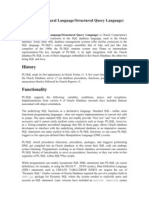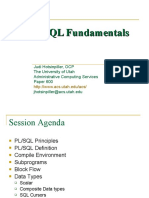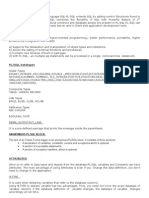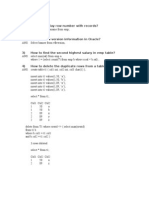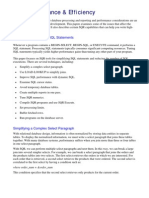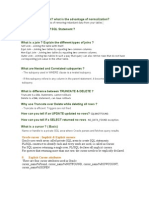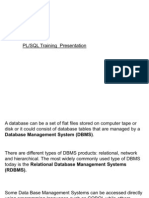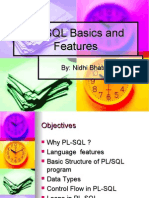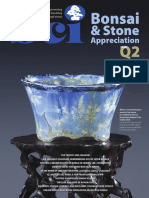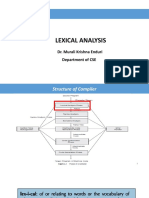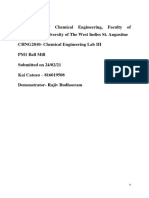Introduction To PLSQL
Introduction To PLSQL
Uploaded by
Yaser.abu-khudierCopyright:
Available Formats
Introduction To PLSQL
Introduction To PLSQL
Uploaded by
Yaser.abu-khudierOriginal Title
Copyright
Available Formats
Share this document
Did you find this document useful?
Is this content inappropriate?
Copyright:
Available Formats
Introduction To PLSQL
Introduction To PLSQL
Uploaded by
Yaser.abu-khudierCopyright:
Available Formats
Introduction to PL/SQL
Need for PL/SQL — declarative vs. procedural — anonymous
blocks — debugging — a first program — code compilation —
code execution — procedures & functions — PL/SQL in SQL
— SQL in PL/SQL — cursors & loops — operators & built-in
functions reference tables.
Introduction PL/SQL is a database-orientated programming language
that extends Oracle SQL with procedural capabilities. We will review in
this lab the fundamental features of the language and learn how to integrate
it with SQL to help solving database problems.
Need for PL/SQL
SQL statements are defined in term of constraints we wish to fix on the result
of a query. Such a language is commonly referred to as declarative. This
contrasts with the so called procedural languages where a program specifies
a list of operations to be performed sequentially to achieve the desired result.
PL/SQL adds selective (i.e. if. . . then. . . else. . . ) and iterative (i.e. loops)
constructs to SQL.
PL/SQL is most useful to write triggers (called rules in Postgres) and
stored procedures. Stored procedures are units of procedural code stored in
a compiled form within the database.
Some PL/SQL
PL/SQL programs are organised in functions, procedures and packages
(somewhat similar to Java packages). There is a limited support for object-
oriented programming. PL/SQL is based on the Ada programming lan-
guage, and as such it shares many elements of its syntax with Pascal.
Your first example in PL/SQL will be an anonymous block —that is a short
program that is ran once, but that is neither named nor stored persistently
in the database.
Jean-Marc Rosengard, 2003 1
SQL> SET SERVEROUTPUT ON
SQL> BEGIN
2 dbms_output.put_line(’Welcome to PL/SQL’);
3 END;
4 /
• SET SERVEROUTPUT ON is the SQL*Plus command1 to activate the con-
sole output. You only need to issue this command once in a SQL*Plus
session.
• the keywords BEGIN...END define a scope and are equivalent to the
curly braces in Java {...}
• a semi-column character (;) marks the end of a statement
• the put line function (in the built-in package dbms output) displays
a string in the SQL*Plus console.
You are referred to Table 2 for a list of operators, and to Table 3 for some
useful built-in functions.
Compiling your code. PL/SQL code is compiled by submitting it to
SQL*Plus. Remember that it is advisable to type your program in an ex-
ternal editor, as you have done with SQL (c.f. “Introduction to Oracle”
laboratory handout).
Debugging. Unless your program is an anonymous block, your errors
will not be reported. Instead, SQL*Plus will display the message “warning:
procedure created with compilation errors”. You will then need to type:
SQL> SHOW ERRORS
to see your errors listed. If yo do not understand the error message and
you are using Oracle on UNIX, you may be able to get a more detailed
description using the oerr utility, otherwise use Oracle’s documentation
(see References section). For example, if Oracle reports “error PLS-00103”,
you should type:
oerr PLS 00103
at the UNIX command prompt (i.e. not in SQL*Plus).
1
Unlike SQL and PL/SQL, SQL*Plus commands are not terminated by a “/”.
Jean-Marc Rosengard, 2003 2
Executing PL/SQL. If you have submitted the program above to Oracle,
you have probably noticed that it is executed straight away. This is the case
for anonymous blocks, but not for procedures and functions. The simplest
way to run a function (e.g. sysdate) is to call it from within an SQL
statement:
SQL> SELECT sysdate FROM DUAL
2 /
Next, we will rewrite the anonymous block above as a procedure. Note that
we now use the user function to greet the user.
CREATE OR REPLACE PROCEDURE welcome
IS
user_name VARCHAR2(8) := user;
BEGIN -- ‘BEGIN’ ex
dbms_output.put_line(’Welcome to PL/SQL, ’
|| user_name || ’!’);
END;
/
Make sure you understand the changes made in the code:
• A variable user name of type VARCHAR2 is declared
• user name is initialised using the user2 built-in function
• “:=” is the assignment operator (c.f. Table 2)
Once you have compiled the procedure, execute it using the EXEC command.
SQL> EXEC welcome
Both procedures and functions should remind you of Java methods. The
similarities and differences between them are outlined in Table 1.
Function Procedure Java Method
Parameters input, output input, output input
Returns
value yes no optional
Can be called
within SQL yes no
Table 1: Functions, procedures and Java methods compared.
2
Procedures and functions with no parameters are not decorated with empty brackets,
like in SQL.
Jean-Marc Rosengard, 2003 3
Embedding SQL in PL/SQL
PL/SQL alone does not allow us to query a database, and use the resulting
data in our program. However, any SQL (i.e. DML) may be embedded in
PL/SQL code. In particular, there exists a form of the “SELECT” statement
for assigning the result of a query to a variable. Note the following code
requires the books and book reviews tables that you should have created
during your first Oracle laboratory.
1 CREATE OR REPLACE PROCEDURE count_reviews
2 (author_param VARCHAR2)
3 IS
4 review_count NUMBER;
5 BEGIN
6 SELECT COUNT(*) INTO review_count
7 FROM book_reviews r, books b
8 WHERE b.isbn = r.isbn AND author = author_param;
9
10 IF review_count > 1 THEN
11 dbms_output.put_line(’There are ’
12 || review_count || ’ reviews.’);
12 ELSIF review_count = 1 THEN
14 dbms_output.put_line(’There is 1 review.’);
15 ELSE
16 dbms_output.put_line(’There is no review.’);
17 END IF;
18 END;
19 /
Note in the code above how:
• the procedure takes one parameter author param of type VARCHAR2
• a value from an SQL query is assigned to a PL/SQL variable (i.e.
review count) using SELECT...INTO... (line 6)
• a value from a PL/SQL variable is used in an SQL statement (line 8)
Try the programs with different authors:
EXEC count_reviews(’Oscar Wilde’)
EXEC count_reviews(’Charles Dickens’)
Jean-Marc Rosengard, 2003 4
Working with Cursors
The last program we are going to write will display the number of reviews
relevant to each author. Notice that the query may now return multiple
rows. However, a SELECT...INTO... statement can only retrieve data from
(at most) one tuple into individual variables.
Cursors3 provide a means to retrieve multiple rows into a buffer (when you
OPEN the cursor) that can then be traversed sequentially (FETCH) to retrieve
individual rows—until there is no more data (cur revs%NOTFOUND becomes
true).
CREATE OR REPLACE PROCEDURE count_by_author
IS
auth VARCHAR2(30);
cnt NUMBER;
CURSOR cur_revs IS
SELECT author, COUNT(author) AS revs_cnt
FROM books b, book_reviews r
WHERE b.isbn = r.isbn GROUP BY author;
BEGIN
OPEN cur_revs;
LOOP
FETCH cur_revs INTO auth, cnt;
EXIT WHEN cur_revs%NOTFOUND;
IF cnt = 0 THEN dbms_output.put_line(’No review for ’
|| auth);
ELSE
dbms_output.put_line(cnt || ’ review(s) for ’ || auth);
END IF;
END LOOP;
CLOSE CUR_REVS;
END;
/
Execute count by author, adding more data to the tables if necessary.
3
Cursors are conceptually similar to iterators in Java.
Jean-Marc Rosengard, 2003 5
Operator Description
+ - / * arithmetic
= equality
!= or <> inequality
|| string concatenation
:= assignment
Table 2: PL/SQL operators.
Function Description
String Functions
upper(s), lower(s) convert string s to upper/lower-case
initcap(s) capitalise first letter of each word
ltrim(s), rtrim(s) remove blank char. from left/right
substr(s,start,len) sub-string of length len from position start
length(s) length of s
Date Functions
sysdate current date (on Oracle server)
to date(date, format) date formatting
Number Functions
round(x) round real number x to integer
mod(n,p) n modulus p
abs(x) absolute value of x
dbms random.random() generate a random integer
Type Conversion Functions
to char() convert to string
to date() convert to date
to number() convert to number
Miscellaneous Functions
user current Oracle user
Table 3: Some Oracle built-in functions. You are referred to Oracles’s doc-
umentation (see References section) for specific usage examples.
References
You can copy & paste the following URI (note that you will need a user-
name/password to access Oracle’s web site. You can use data@base.com/database):
PL/SQL User’s Guide and Reference:
http://otn.oracle.com/doc/server.815/a67842/toc.htm
Jean-Marc Rosengard, 2003 6
You might also like
- Epson DS 7000 Service ManualDocument2 pagesEpson DS 7000 Service Manualchrisban350% (3)
- 0471778648Document352 pages0471778648Diane Kirby90% (10)
- Chapter 1 2 3Document16 pagesChapter 1 2 3Novia Nurul LailyNo ratings yet
- PLSQL_HandBookDocument18 pagesPLSQL_HandBookbestie1902.2704No ratings yet
- Oracle Interview Questions and Answers: SQL: 1. To See Current User NameDocument18 pagesOracle Interview Questions and Answers: SQL: 1. To See Current User NameswarooperNo ratings yet
- Oracle Interview Questions and Answers: SQLDocument28 pagesOracle Interview Questions and Answers: SQLThirupathi Reddy LingalaNo ratings yet
- 2.1 Direct Interpretation: Awk Myscript - SHDocument5 pages2.1 Direct Interpretation: Awk Myscript - SHShmita GheldaNo ratings yet
- Oracle SQL BasicsDocument60 pagesOracle SQL Basicsmidhilesh sagarNo ratings yet
- Dbms Unit 5 FinalDocument16 pagesDbms Unit 5 FinalSoma Raju JyothulaNo ratings yet
- PLSQLmy UpdatedDocument71 pagesPLSQLmy UpdatedAnish KumarNo ratings yet
- Oracle PLSQL Interview AdvDocument25 pagesOracle PLSQL Interview AdvZainul AbdeenNo ratings yet
- PL/SQL NotesDocument17 pagesPL/SQL NotesnitishghosalNo ratings yet
- Introduction To Oracle: SQL PlusDocument6 pagesIntroduction To Oracle: SQL PlusYaser.abu-khudier100% (1)
- 2004 Presentation 600Document48 pages2004 Presentation 600midhungbabu88No ratings yet
- Beginning SQL,: Differences Between Oracle and MicrosoftDocument9 pagesBeginning SQL,: Differences Between Oracle and MicrosoftQasim ButtNo ratings yet
- SQL Scripting & AMDPDocument11 pagesSQL Scripting & AMDPgvrahul100% (1)
- Oracle 1Document8 pagesOracle 1Mahidhar KoppulaNo ratings yet
- SQL NoteDocument18 pagesSQL NoteAmit BansalNo ratings yet
- Oracle Interview QuestionsDocument87 pagesOracle Interview Questionssmruti_2012100% (1)
- PLSQL 1Document69 pagesPLSQL 1api-3752301100% (1)
- Write A Query To Assign Create, Select, Update Privilege On Empno Column of Emp Table To Rahul UserDocument7 pagesWrite A Query To Assign Create, Select, Update Privilege On Empno Column of Emp Table To Rahul Usertishakhatri1511No ratings yet
- Pls QL NotesDocument9 pagesPls QL NotesPraful PundeNo ratings yet
- Lab ManualDocument44 pagesLab ManualdawodNo ratings yet
- Oracle and PLDocument7 pagesOracle and PLAbhinav GonuguntlaNo ratings yet
- SQL McqsDocument4 pagesSQL McqseliyazNo ratings yet
- Advanced PLSQL - UpdatedDocument81 pagesAdvanced PLSQL - UpdatedredroNo ratings yet
- Unit 5 PLSQLDocument15 pagesUnit 5 PLSQLluvyharishNo ratings yet
- PL SQLDocument8 pagesPL SQLprasadNo ratings yet
- PLSQLDocument49 pagesPLSQLtanmayi nandirajuNo ratings yet
- PL SQL Notes OnlyDocument17 pagesPL SQL Notes Onlywritesmd100% (16)
- Client Server Model: Many Databases Applications Are Built inDocument52 pagesClient Server Model: Many Databases Applications Are Built inShriNo ratings yet
- Interview QuestionsDocument12 pagesInterview QuestionsAli NaveedNo ratings yet
- SQR Performance & EfficiencyDocument10 pagesSQR Performance & EfficiencyKalicharan ReddyNo ratings yet
- PL sql1Document47 pagesPL sql1SyedNo ratings yet
- QuestionsDocument7 pagesQuestionsTarun SharmaNo ratings yet
- 06 PL & SQLDocument12 pages06 PL & SQLSagar Paul'gNo ratings yet
- SQL - Questions & AnswersDocument22 pagesSQL - Questions & AnswersPriya AroraNo ratings yet
- PL/SQL Workbook: For Use in Association WithDocument20 pagesPL/SQL Workbook: For Use in Association WithGanapathiraju SravaniNo ratings yet
- Performance and Tuning: Oracle Initialization Parameters Used in The Compilation of PLSQL UnitsDocument19 pagesPerformance and Tuning: Oracle Initialization Parameters Used in The Compilation of PLSQL UnitsYathindra sheshappaNo ratings yet
- Oracle SQL TutorialDocument22 pagesOracle SQL TutorialSandeep TiwariNo ratings yet
- Database Training PresentationDocument36 pagesDatabase Training Presentationramya9288No ratings yet
- Dbms FileDocument25 pagesDbms FileKanika JawlaNo ratings yet
- SQL CURSOR ProgrammingDocument11 pagesSQL CURSOR ProgrammingPrasanna KamthankarNo ratings yet
- My PLSQL NotesDocument131 pagesMy PLSQL Notesmrahul_3000No ratings yet
- SQLDocument53 pagesSQLÇağatay AbayNo ratings yet
- KKW Unit 4 PL-SOL ProgrammingDocument39 pagesKKW Unit 4 PL-SOL Programmingthakkarparth793No ratings yet
- PLSQLDocument45 pagesPLSQLNeha MendjogeNo ratings yet
- PL SQL by NareshDocument607 pagesPL SQL by Nareshnareshpeddapati100% (3)
- BulkOp - ForAll & Bulk CollectDocument20 pagesBulkOp - ForAll & Bulk Collectsbukka100% (3)
- PLSQL PractDocument51 pagesPLSQL PractSTAN_ZXTNo ratings yet
- 09 Single-Row FunctionsDocument99 pages09 Single-Row FunctionsMarilyn UrmatanNo ratings yet
- PLSQLDocument21 pagesPLSQLvipanaroraNo ratings yet
- PLSQL Program FileDocument20 pagesPLSQL Program Filepushpa kesarwaniNo ratings yet
- SQL Interview QuestionsDocument12 pagesSQL Interview QuestionsKalyan KishoreNo ratings yet
- Advanced SAS Interview Questions You'll Most Likely Be AskedFrom EverandAdvanced SAS Interview Questions You'll Most Likely Be AskedNo ratings yet
- SAP interface programming with RFC and VBA: Edit SAP data with MS AccessFrom EverandSAP interface programming with RFC and VBA: Edit SAP data with MS AccessNo ratings yet
- What Is Sql ?: Fundamentals of Sql,T-Sql,Pl/Sql and Datawarehousing.From EverandWhat Is Sql ?: Fundamentals of Sql,T-Sql,Pl/Sql and Datawarehousing.No ratings yet
- Practical Reverse Engineering: x86, x64, ARM, Windows Kernel, Reversing Tools, and ObfuscationFrom EverandPractical Reverse Engineering: x86, x64, ARM, Windows Kernel, Reversing Tools, and ObfuscationNo ratings yet
- Sed CommandDocument15 pagesSed CommandsampurnakumarNo ratings yet
- Expanplast SRDocument3 pagesExpanplast SRAmar Wadood KhanNo ratings yet
- Folleto Tríptico GA1-240202501-AA2-EV01Document2 pagesFolleto Tríptico GA1-240202501-AA2-EV01STELLA0% (1)
- Bci 2020 Q2Document76 pagesBci 2020 Q2Andrés vargasNo ratings yet
- American Structuralism (Descriptivism)Document18 pagesAmerican Structuralism (Descriptivism)astaNo ratings yet
- Chapter 1-7Document224 pagesChapter 1-7Jackie JonesNo ratings yet
- Instruction For Completing The Summary of Bid Prices:: NEN Builders and Development Services CorpDocument54 pagesInstruction For Completing The Summary of Bid Prices:: NEN Builders and Development Services CorpDave FederisoNo ratings yet
- Lexical Analysis: Dr. Murali Krishna Enduri Department of CSEDocument88 pagesLexical Analysis: Dr. Murali Krishna Enduri Department of CSEJaswanth SuggulaNo ratings yet
- Unit03 Matrices and DeterminantsDocument34 pagesUnit03 Matrices and DeterminantsThành NhanNo ratings yet
- Ball MillDocument37 pagesBall MillElisha DanielNo ratings yet
- Og Uhv MiniprojectDocument13 pagesOg Uhv Miniprojectkanchiagarwal54No ratings yet
- Computer Organization Lab 17012013Document22 pagesComputer Organization Lab 17012013R K S B O TNo ratings yet
- Psychology of CultsDocument7 pagesPsychology of CultsRidhi AgarwalNo ratings yet
- Eom BoeingDocument3 pagesEom BoeingJsvm GautamNo ratings yet
- Moment VectorDocument9 pagesMoment VectorGlen GulayNo ratings yet
- The Druid Path (Marah Ellis Ryan) (Z-Library)Document23 pagesThe Druid Path (Marah Ellis Ryan) (Z-Library)Joseph VillalobosNo ratings yet
- Answer of Pro and StatDocument405 pagesAnswer of Pro and StatZe Xu67% (3)
- CJE Vol 16 No 1 2014 Boric SkugorDocument16 pagesCJE Vol 16 No 1 2014 Boric Skugormateoscribd1No ratings yet
- Types of Vacuum CleanersDocument2 pagesTypes of Vacuum CleanersAlex DA CostaNo ratings yet
- Problems On AnalogyDocument19 pagesProblems On AnalogyRavi TejaNo ratings yet
- Integrated ADocument101 pagesIntegrated ARyan M. TigbaoNo ratings yet
- Obituary Kiyoshi MutoDocument1 pageObituary Kiyoshi Mutokiert.sahasakNo ratings yet
- 65 2 2 MathematicsDocument23 pages65 2 2 MathematicstejNo ratings yet
- People MediaDocument42 pagesPeople Mediaadrianeenerva0No ratings yet
- Deadzone 3.0 Rebels 100pt ListDocument3 pagesDeadzone 3.0 Rebels 100pt ListchinksterNo ratings yet
- CrowleyDocument18 pagesCrowleyevgenijkent9No ratings yet
- Flowchart Cash ReceiptDocument4 pagesFlowchart Cash Receiptalif nur irvanNo ratings yet











